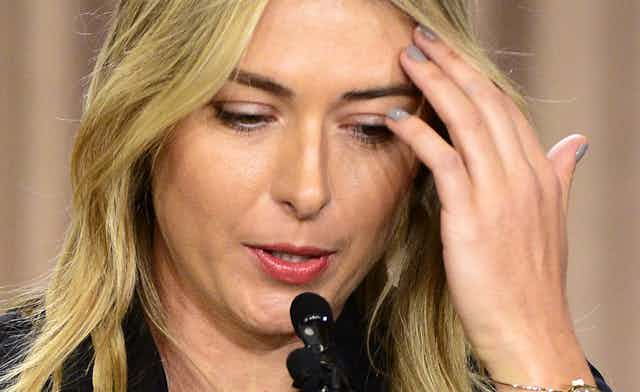Overnight, Maria Sharapova called a press conference to announce she had tested positive for a banned substance (mildronate) during this year’s Australian Open.
Originally, speculation had been that the press conference was to announce her retirement from tennis, but a failed drugs test may amount to the same thing. At the age of 28, and plagued by injuries for much of her career, a mandatory two-year ban (for the unknowing use of a banned substance, which might become four if “knowing” use is established) may prove too high a barrier to overcome.
Sharapova is the latest high-profile sportsperson to test positive to mildronate in the last month, following one of the best-known Russian figure skaters, Ekaterina Bobrova, and veteran cyclist Eduard Vorganov.
What is mildronate?
Mildronate (also known as meldonium) has been a quiet secret in performance-enhancement circles for many years. This may be partly because most of the research on it was published in Russian and the drug is not commonly used outside Eastern Europe. After its development in Latvia in the 1970s, research was first published around ten years later and focused largely on the drug’s therapeutic potential for patients with heart muscle damage.
Technically, mildronate inhibits carnitine, an amino acid derivative that transports fatty acids into mitochondria (the “power houses” of a cell). Less carnitine means less utilisation of those fatty acids for fuel, which forces the body to burn carbohydrates for fuel. This is a far more efficient process than fatty oxidation, which is very “expensive” in the amount of oxygen it requires.
Mildronate is typically prescribed for angina (when the heart muscle doesn’t receive enough oxygen from the blood), as it reduces the overall oxygen consumption necessary. For athletes, though, this reduction in oxygen demand translates into an increase in performance – for instance, increased endurance and aerobic properties, and faster recovery. While there isn’t a great deal of information available, the drug appears to be well tolerated and has a favourable risk profile.

Only on January 1 this year was mildronate added to the World Anti-Doping Agency’s list of banned substances after it was monitored for a year. The agency collected samples to determine if athletes regularly used the drug.
WADA found evidence of widespread use – more than 180 positive results from a sample of 8,320, which is a positive rate of more than 2%. Most of these results were from periods of competition (not breaks between competition seasons) and more than half were from the strength sport athletes.
WADA monitors substances, develops analytical tests for their detection and finally bans them. These substances are generally drugs that are developed for specific medical concerns. Anabolic steroids are the original template for this, as much of the original research from the 1930s was initially used to help people with various muscle-wasting conditions (such as cancer and HIV/AIDS) or hormonal problems.
Who’s to blame?
Sharapova’s claim is that her prescription for the drug is ongoing, legal and had been maintained since 2006 to treat a magnesium deficiency, diabetes and a congenital heart problem.
So far, not enough information is available to evaluate the likelihood of this claim.
Certainly magnesium deficiency is common enough in sports people, to the extent it is one of the first conditions that would be checked if the athlete reports “unexpected fatigue”. Magnesium deficiency is straightforward to treat with supplemental magnesium. This can be administered by tablet, capsule, injection or even by inhaler in acute cases.
What might be possible at this point is to apply for a therapeutic use exemption, which is a request to use a controlled substance despite banned or restricted status. In this case, the therapeutic use exemption would have to apply retroactively.
The rules here are unclear, as WADA allows a retroactive therapeutic use exemption in cases of:
a) medical emergency
b) extraordinary circumstances, or – and this is very unclear –
c) if they feel it would be “fair” to allow such an exemption.
In other words, if a doctor prescribed mildronate (and that prescription is justified by good medical evidence), Sharapova may have a case.
Failing that, the WADA rules are very clear about banned substances – unless you can conclusively prove you were inadvertently contaminated, your positive test is regarded as the only evidence necessary.
It is possible that Sharapova’s drug use was just a bad oversight on her part, but this may not change the outcome. Professional athletes these days are usually scrupulously careful about their supplement and medication use. This goes doubly for athletes who have a public image or endorsements to lose in the face of drug use claims.
However, they are also often taking a dizzying array of vitamin and mineral support, legal and grey-market performance-enhancers and prescribed/approved medications for ongoing conditions. It could well be difficult to keep track of all of them.
More than anything else, this is a failure of management. A sportsperson is not a pharmacologist, and Sharapova cannot be expected to know the specific pharmacology behind the range of medical and supplemental support she is taking, especially if this is changed or elevated because of injury.

